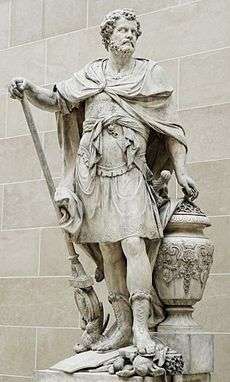Sébastien Slodtz

Sébastien Slodtz (1655–1726) was a French sculptor, the father of a trio of brothers who helped shape official French sculpture between the Baroque and the Rococo. He was born at Antwerp and joined the Paris workshop of François Girardon, under whose direction he worked for the sculptural decor of Versailles and its gardens and for the Tuileries. Sébastien Slodtz was the outstanding sculptor to come out of Girardon's atelier (Souchal 1968). He held the post of Dessinateur de la Chambre et du Cabinet de Sa Majesté, a post that two of his sons filled after him.
Sébastien Slodtz is best known for his Aristaeus fettering Proteus, begun in 1688, installed in 1714 in the Bassin d'Apollon on the grand terrace at Versailles, where it remains. His other chief works were the Hannibal Barca counting the rings of the Roman knights killed at the Battle of Cannae (illustration) for the Allée du Roi, which was designed as a pendant for Nicolas Coustou's Julius Caesar and for which Girardon provided a terracotta maquette[1] a statue of St Ambrose in the Dôme des Invalides, and a bas-relief Saint Louis sending missionaries to India. Other works were provided for the Château de Marly, such as the marble Vertumnus for the Cascade and sculptures for the Val-de-Grâce.
His sons, notably René-Michel Slodtz (1705–64) called Michelange, the only great sculptor among the Slodtz, according to François Souchal, but also his two brothers, who worked in partnership largely for the ephemeral royal and princely occasions overseen by the department of the Menus Plaisirs: the designer-decorator Sébastien-Antoine (1695–1754) and the sculptor Paul-Ambroise (1702–58), who was the only one of the three to be accepted in the Académie royale de peinture et de sculpture. Their lively, dashing drawings cannot be told apart, even by specialists.
Among the pupils of Sébastien Slodtz was Pierre de L’Estache.
References
| Wikimedia Commons has media related to Sébastien Slodtz. |
- ↑ The pair of sculptures were removed to the Jardin des Tuileries in 1722; in 1872 they were removed to the Musée du Louvre.
- Souchal, François 1968.Les Slodtz sculpteurs et decorateurs du Roi (1685-1764) Reviewed by Terence Hodgkinson, The Burlington Magazine 111 (March 1969), pp. 156, 159-160.